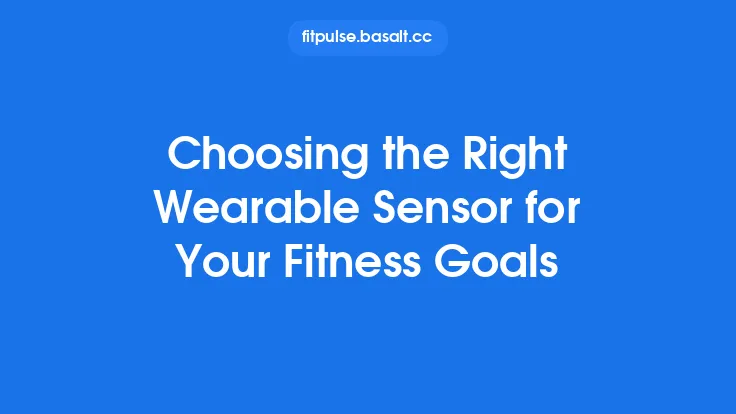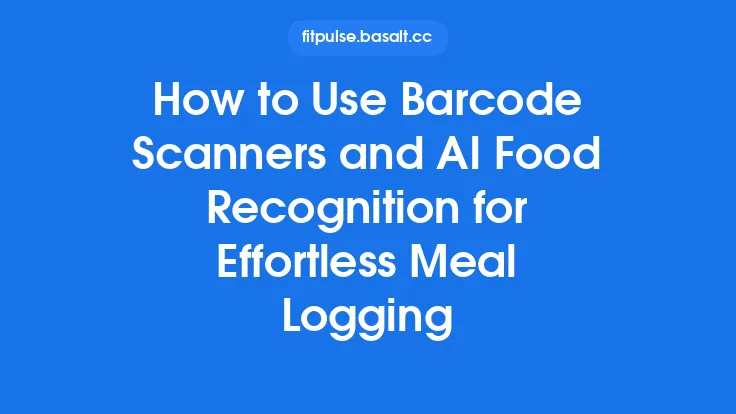Keeping a clear picture of what you eat and how active you are is one of the most powerful ways to understand your health. While many people log meals in a dedicated nutrition app and track steps or heart rate on a wrist‑worn device, the real magic happens when those two data streams talk to each other. When your food diary and wearable fitness tracker are synchronized, you gain a unified view of calories in versus calories out, see how macronutrient timing influences performance, and receive smarter, context‑aware recommendations—all without the mental overhead of manual data entry.
Below is a comprehensive guide that walks you through the technical foundations, practical steps, and best‑practice strategies for achieving seamless integration between your food‑logging platform and your wearable. The information is evergreen, meaning it will remain relevant even as new devices and software updates roll out.
Understanding the Data Landscape
1. What Types of Data Are Exchanged?
- Nutritional Intake – calories, macronutrients (protein, carbs, fat), micronutrients (vitamins, minerals), fiber, sugar, sodium, and sometimes meal timing.
- Activity Metrics – steps, distance, active minutes, heart rate zones, VO₂ max, sleep stages, and calorie expenditure.
- Contextual Signals – GPS location, workout type, stress levels, and body composition measurements (e.g., body fat % from bio‑impedance scales).
When these data points are merged, the platform can calculate net energy balance, nutrient‑exercise correlations, and personalized hydration or recovery cues.
2. Common Data Formats and Standards
- JSON (JavaScript Object Notation) – the de‑facto format for API payloads. Most modern nutrition and fitness services expose endpoints that accept or return JSON objects.
- CSV (Comma‑Separated Values) – useful for bulk imports/exports, especially when moving data between legacy tools.
- FHIR (Fast Healthcare Interoperability Resources) – an emerging standard in health tech that defines how nutrition, activity, and clinical data can be shared securely. Some high‑end wearables and health platforms are beginning to adopt FHIR for better cross‑system compatibility.
Understanding these formats helps you decide whether you’ll rely on native integrations (built‑in sync) or need a custom middleware solution.
Choosing Compatible Platforms
1. Native Ecosystem Pairings
Many manufacturers design their own nutrition and fitness ecosystems to work out‑of‑the‑box. For example:
- Apple Watch + Apple Health – Apple Health acts as a central hub, pulling food logs from apps like MyFitnessPal, Cronometer, or Lose It! and merging them with activity data from the Watch.
- Garmin Wearables + Garmin Connect – Garmin’s “Nutrition” tab can import meals from third‑party apps via the Garmin Connect API.
- Fitbit + Fitbit App – Fitbit’s “Food” log integrates directly with its activity dashboard, and the platform offers a public API for external apps.
If you stay within a single ecosystem, you often avoid the need for manual token handling or data mapping.
2. Cross‑Platform Integration Options
When your favorite food‑logging app and wearable belong to different ecosystems, you have three main pathways:
| Approach | Description | Typical Use Cases |
|---|---|---|
| Official Third‑Party Sync | The nutrition app provides a built‑in “Connect to X Wearable” button that uses OAuth to grant access to the wearable’s API. | MyFitnessPal ↔︎ Garmin Connect, Cronometer ↔︎ Apple Health |
| Open‑Source Middleware | Tools like IFTTT, Zapier, or community‑maintained scripts (e.g., on GitHub) act as bridges, pulling data from one API and pushing it to another on a schedule. | Syncing a niche app that lacks a direct partnership with a popular smartwatch |
| Custom API Integration | You develop a small service (often hosted on a cloud platform) that authenticates with both APIs, normalizes the data, and writes it to each system. | Enterprises or power users who need precise control over data fields, frequency, and error handling |
Choosing the right approach depends on your technical comfort level, the frequency of data updates you need, and any privacy constraints you wish to enforce.
Technical Walkthrough: Setting Up a Custom Sync
Below is a step‑by‑step blueprint for building a lightweight sync service using Python. The same logic can be ported to JavaScript, Ruby, or any language that can make HTTPS requests.
1. Gather API Credentials
- Nutrition App – Register a developer account, create an OAuth client, and note the `clientid`, `clientsecret`, and redirect URI.
- Wearable Platform – Follow the vendor’s developer portal to obtain similar credentials. Some platforms (e.g., Garmin) use OAuth 1.0a, while others (e.g., Apple Health) rely on HealthKit permissions that are granted on the device.
2. Implement OAuth Flow
import requests
from requests_oauthlib import OAuth2Session
# Example for a generic OAuth2 nutrition API
nutri = OAuth2Session(client_id, redirect_uri='https://yourapp.com/callback')
authorization_url, state = nutri.authorization_url('https://api.nutriapp.com/oauth/authorize')
print('Visit this URL to authorize:', authorization_url)
# After user authorizes, they are redirected to your callback with a code
response = nutri.fetch_token('https://api.nutriapp.com/oauth/token',
client_secret=client_secret,
code='CODE_FROM_CALLBACK')
access_token = response['access_token']
Store the `access_token` securely (e.g., encrypted environment variable or secret manager). Refresh tokens periodically according to each API’s policy.
3. Pull Daily Food Logs
def fetch_food_log(date_str):
url = f'https://api.nutriapp.com/v1/foodlog/{date_str}'
headers = {'Authorization': f'Bearer {access_token}'}
r = requests.get(url, headers=headers)
r.raise_for_status()
return r.json() # Returns a list of meals with nutrient breakdowns
4. Transform Data to Wearable Schema
Most wearable APIs expect a calorie expenditure payload, not a full nutrient breakdown. However, you can embed additional fields in a “custom data” section if the platform supports it.
def map_to_wearable(food_entry):
return {
"date": food_entry["date"],
"calories": food_entry["total_calories"],
"protein_g": food_entry["macros"]["protein"],
"carbs_g": food_entry["macros"]["carbohydrates"],
"fat_g": food_entry["macros"]["fat"]
}
5. Push to Wearable API
def push_to_wearable(payload):
url = 'https://api.wearable.com/v2/nutrition'
headers = {
'Authorization': f'Bearer {wearable_access_token}',
'Content-Type': 'application/json'
}
r = requests.post(url, json=payload, headers=headers)
r.raise_for_status()
return r.json()
6. Schedule the Sync
Use a cloud scheduler (AWS EventBridge, Google Cloud Scheduler, or a simple cron job) to run the script once per day, preferably after you finish logging meals.
0 23 * * * /usr/bin/python3 /home/user/sync_food_wearable.py >> /var/log/sync.log 2>&1
7. Error Handling & Retries
- Rate Limits – Respect `Retry-After` headers; back‑off exponentially.
- Partial Failures – Log which meals failed and attempt a retry on the next run.
- Data Validation – Ensure numeric fields are non‑negative and timestamps are in ISO‑8601 format to avoid ingestion errors.
Leveraging the Integrated Data
Once the sync is live, the combined dataset unlocks several practical benefits:
1. Real‑Time Energy Balance Dashboard
Display a single chart that plots calories consumed vs. calories burned throughout the day. Highlight periods where intake exceeds expenditure, helping you make on‑the‑fly adjustments (e.g., swapping a snack for a low‑calorie alternative).
2. Nutrient‑Performance Correlation Insights
By aligning macronutrient timing with workout intensity zones, you can discover patterns such as:
- Higher carbohydrate intake 2‑3 hours before high‑intensity interval training (HIIT) improves average power output.
- Consistent protein intake post‑run correlates with faster recovery metrics (lower resting heart rate variability).
These insights can be visualized in a “Nutrition‑Performance Heatmap” that updates automatically as new data arrives.
3. Automated Goal Adjustments
If your wearable’s AI engine detects a sustained calorie deficit, it can suggest:
- Slightly increasing daily calorie targets in the nutrition app.
- Adding a short “active recovery” walk to meet step goals without over‑exertion.
Conversely, a chronic surplus can trigger gentle alerts to log a light activity session.
4. Personalized Hydration Reminders (Without Duplicating Hydration Articles)
Even though the focus here is nutrition, the integrated system can infer fluid needs based on total sodium intake and sweat rate derived from heart rate and ambient temperature data. The wearable can then push a discreet vibration reminder when you’re likely to be dehydrated, without delving into dedicated hydration device reviews.
Privacy, Security, and Data Ownership
1. Token Management
- Store OAuth tokens in encrypted storage (e.g., AWS Secrets Manager, Azure Key Vault).
- Rotate refresh tokens regularly and revoke them if you suspect compromise.
2. Scope Minimization
When requesting permissions, ask only for the data you truly need:
- `nutrition.read` and `nutrition.write` rather than `profile.full_access`.
- `activity.read` instead of `activity.write` unless you plan to push corrective data back to the wearable.
3. GDPR & CCPA Compliance
If you reside in the EU or California, ensure:
- Users can request a full export of their combined data.
- You provide a clear privacy policy describing how the sync service processes information.
- Data is retained only as long as necessary for the sync purpose.
4. Local vs. Cloud Processing
For the most privacy‑conscious users, run the sync script on a personal device (e.g., a Raspberry Pi) rather than a cloud server. This keeps API keys and personal health data within your own network.
Troubleshooting Common Issues
| Symptom | Likely Cause | Fix |
|---|---|---|
| No new meals appear on the wearable dashboard | Nutrition API token expired | Refresh the token or re‑run the OAuth flow |
| Duplicate entries for the same day | Scheduler runs twice or script lacks idempotency check | Add a hash of the payload and skip if already uploaded |
| Calories don’t match activity‑derived burn | Wearable uses MET‑based estimation while nutrition app uses food label values | Verify that both systems use the same unit (kcal vs. kJ) and adjust conversion if needed |
| API returns 429 Too Many Requests | Exceeding rate limits during bulk sync | Implement exponential back‑off and batch requests in smaller chunks |
| Data appears out of sync by several hours | Timezone mismatch between services | Normalize all timestamps to UTC before sending, then let each platform display in the user’s local timezone |
Keeping a simple log file that records request IDs, timestamps, and response codes can dramatically reduce the time spent hunting down these problems.
Future‑Proofing Your Integration
1. Watch for Emerging Standards
- Open mHealth and FHIR are gaining traction for health data exchange. When a wearable announces FHIR support, you can replace custom JSON mapping with a standardized resource model, reducing maintenance overhead.
- OAuth 2.1 introduces tighter security (PKCE, token binding). Updating your auth flow early avoids future migration headaches.
2. Modular Architecture
Design your sync service as independent modules:
- Auth Layer – handles token acquisition and refresh.
- Fetch Layer – pulls data from the nutrition source.
- Transform Layer – maps fields to a neutral schema.
- Push Layer – writes to the wearable endpoint.
If either API changes, you only need to adjust the corresponding module.
3. Leverage Community Plugins
Platforms like Home Assistant and OpenHAB now include “Health Integration” components that can ingest nutrition data and expose it to wearables via MQTT or Webhooks. Monitoring these ecosystems can provide low‑code alternatives when you prefer not to maintain a custom script.
Recap: The Value of a Unified Food‑Fitness View
- Holistic Insight – See the full picture of intake vs. expenditure, enabling smarter daily decisions.
- Automation – Reduce manual entry, freeing mental bandwidth for training and life.
- Personalization – Let data‑driven algorithms tailor calorie targets, macronutrient timing, and activity suggestions.
- Control – By building or choosing the right integration method, you retain ownership of your health data and can adapt the system as technology evolves.
By following the principles, technical steps, and best‑practice guidelines outlined above, you can create a robust, evergreen pipeline that keeps your food diary and wearable fitness tracker perfectly in sync—turning raw numbers into actionable health intelligence.



